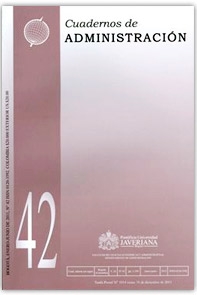O modelo IEI, um novo conceito de conexão de sucessores potenciais da empresa familiar
##plugins.themes.bootstrap3.article.details##
Fundamentado na teoria de recursos e habilidades, a qual busca identificar o
potencial da empresa para estabelecer as vantagens competitivas, este artigo explora um novo modelo de conexão em tempo integral de potenciais sucessores da empresa familiar (ef): o modelo iei (interino, externo, interno). Neste modelo, o sucessor em potencial deverá trabalhar determinadamente em tempo integral na ef, para então sair e realizar uma experiência externa, e posteriormente voltar à empresa familiar. A pesquisa explora a importância do modelo iei na ef, com um estudo de caso de uma empresa colombiana de médio porte. Os resultados mostram que este modelo pode ser considerado como uma alternativa de conexão dos descendentes na ef, e resulta em propostas que deverão ser contrastadas em pesquisas posteriores.
successor, engagement, formation of future generations, family businesssucesor, vinculación, formación de las siguientes generaciones, empresa familiarsucessor, conexão, formação das próximas gerações, empresa familiar
Barach, J. A.; Ganitzky, J.; Carson, J. A. and Doochin, B. A. (1988). Entry of the next generation: strategic challenge for family business. Journal of Small Business Management, 26 (2), 49-56.
Barney, J. (1991). Firm resources and sustained competitive advantage. Journal of Management, 17 (1), 99-120.
Birley, S. (1986). Succession in the family firm: The inheritor's view. Journal of Small Business Management, 24 (3), 36-42.
Cabrera, K. (2005). Leadership transfer and the succesor's development in the family business. The Leadership Quaterly, 16, 71-96.
Cadieux, L. (2007). Succession in small and medium-sized family business: Toward a typology of predecessor roles during and after instatement of the successor. Family Business Review, 20 (2), 95-109.
Davis, J. A. and Tagiuri, R. (1989). The influence of life stage on father-son work relationship in family companies. Family Business Review, 2 (1), 47-74.
Diericx, I. and Cool, K. (1989). Asset stock accumulation and the sustainability competitive advantage. Management Science, 35, 1504-1511.
García, M. E. and López, J. (2001). A taxonomy of founders based on values: The root of family business heterogeneity. Family Business Review, 14 (3), 209-227.
García, M. E., López, J. and Saldaña, P. (2002). Socialization patterns of successors in first to second-generation family businesses. Family Business Review, 15 (3), 189-203.
Goldberg, S. D. (1996). Effective successors in family owned business: Significant elements. Family Business Review, 9 (2), 185-197.
Haberman, H. and Danes, S. (2007). Father-daughter and father-son family business management transfer comparison: Family FIRO model application. Family Business Review, 20 (2), 163-184.
Handler, W. C. (1989). Managing the family firm succession process: The next generation family members' experience. Disertación de tesis doctoral. Massachusetts: Boston University.
Handler, W. C. (1994). Succession in family business: A review of the research, Family Business Review, 7 (2), 133-157.
Harvey, M. and Evans, R. E. (1994). The impact of timing and mode of entry on successor development and successful succession. Family Business Review, 7 (1), 221-236.
Kirby, D. and Lee, T. (1996). Succession management in family firms in the North East of England, Family Business Review, 9 (1), 75-85.
Lambrecht, J. (2005). Multigenerational transition in family business: A new explanatory model. Family Business Review, 18 (4), 267-282.
Le Breton, I; Miller, D. and Steier, Ll. P. (2004). Toward and integrative model of effective FOB succession. Entrepreneurship Theory and Practice, 28 (4), 305-328.
Longenecker, J. and Schoen, J. (1978). Management succession in the family business. Journal of Small Business Management, 16 (3), 1-6.
Lozano, M. y Urbano, D. (2008a). La vinculación de descendientes a la empresa familiar, un estudio de casos colombianos. Estudios Gerenciales, 24 (109), 37-63.
Lozano, M. y Urbano, D. (2008b). Elementos del proceso de formación de descendientes antes de su vinculación a la empresa familiar: un estudio de casos colombianos. Cuadernos de Administración, 21 (37), 243-268.
Marshall, C. and Rossman, G. B. (1995). Designing Qualitative Research, 2a. ed. Thousand Oaks: Sage Publications.
McClellan, E.; McQueen, K. M. and Neidig, J. L. (2003). Beyond the qualitative interview: Data preparation and transcription. Field Methods, 15 (1), 63-84.
Miles, M. B. and Huberman, A. M. (1994). Qualitative data analysis: A sourcebook of new methods. Thousand Oaks: Sage Publications.
Navas, J. L. y Guerras, L. A. (1998). La dirección estratégica de la empresa. Teoría y aplicaciones, 2a. ed. Madrid: Civitas.
Peteraf, M. (1993). The cornerstones of competitive advantage: A resource-base view. Strategic Management Journal, 14, 179-191.
Porter, M. (1980). Competitive strategy: Techniques for analyzing industries and competitors. New York: The Free Press.
Sharma, P.; Chrisman James and Chua, J. (2003b). Succession planning as planned behavior: Some empirical results. Family Business Review, 16 (1), 1-15.
Sharma, P.; Chrisman, J. and Chua, J. (1997). Strategic management of the family business: Past research and future challenges. Family Business Review, 10 (1), 1-35.
Sharma, P.; Chrisman, J. and Chua, J. (2003a). Predictors of satisfaction with the succession process in family firms. Journal of Business Venturing, 18 (5), 667-687.
Stavrou, E. (1998). A four factor model: A guide to planning next generation involvement in the family firm. Family Business Review, 11 (2), 135-141.
Stavrou, E. and Swiercz, P. M. (1998). Securing the future of the family enterprise: A model of offspring intentions to join the business. Entrepreneurship Theory and Practice, 23 (2), 19-39.
Ussman, A. M. (1994). A transferencia de geracao na direccao das empresas familiares em Portugal. Doctoral Dissertation. Universidade Da Beira Interior, Portugal - Universidad Autónoma de Barcelona, España.
Venter, E.; Boshoff, C. and Maas, G. (2005). The influence of successor-related factors on the succession process in small and medium-sized family businesses. Family Business Review, 18 (4), 283-303.
Ward, J. L. and Sorenson, L.S. (1988). Turning children into managers. Nation's Business, 76 (8), 49.
Ward, J. L. (1994). Cómo desarrollar la empresa familiar. Buenos Aires: El Ateneo.
Wernerfelt, B. (1984). A resource-based view of the firm. Strategic Management Journal, 5, 171-180.
Wortman Jr., M. (1994). Theoretical foundations for family-owned businesses: A conceptual and research based paradigm. Family Business Review, 7 (1), 3-27.
Yin, R. K. (1994). Case Study Research. Design and Methods. London: Sage Publications.


